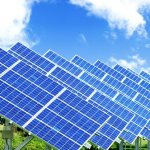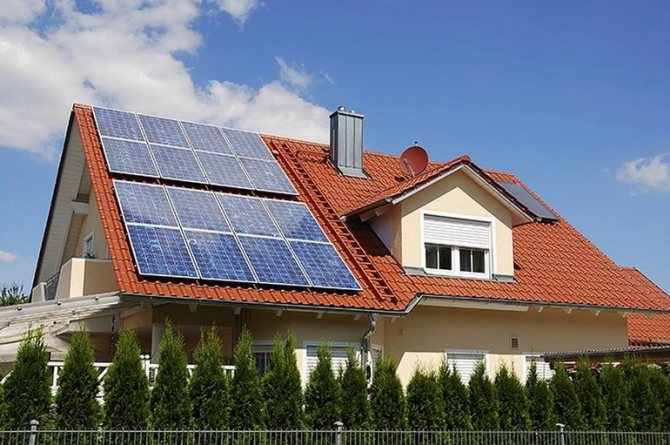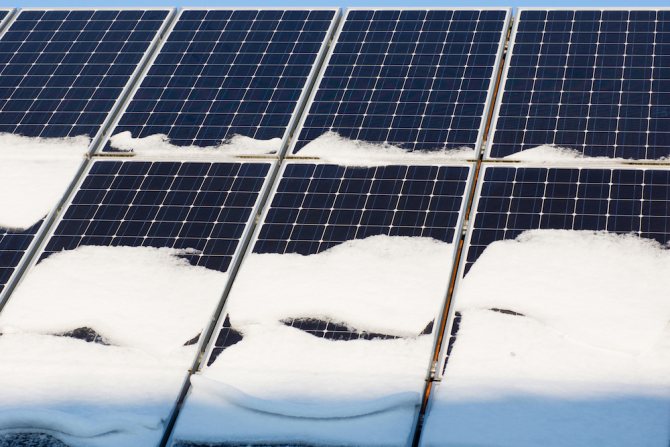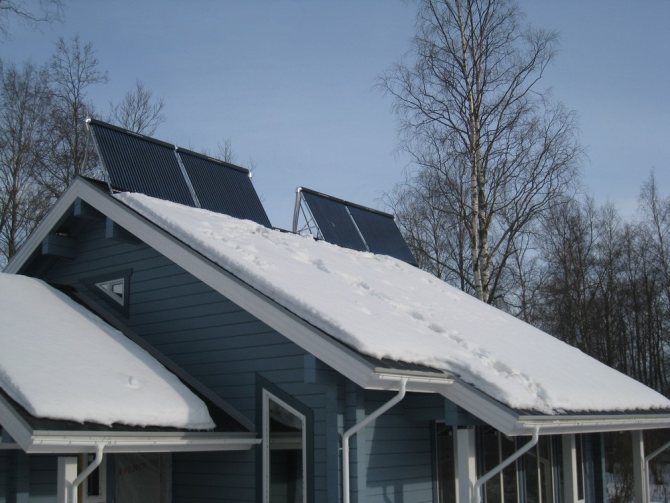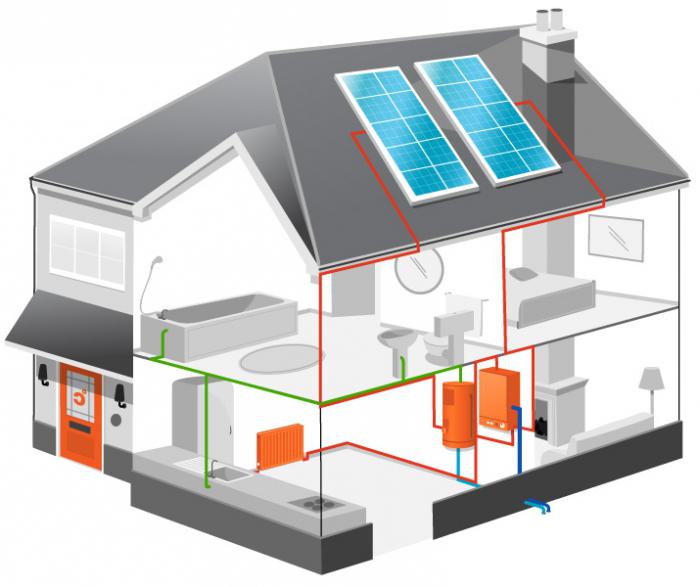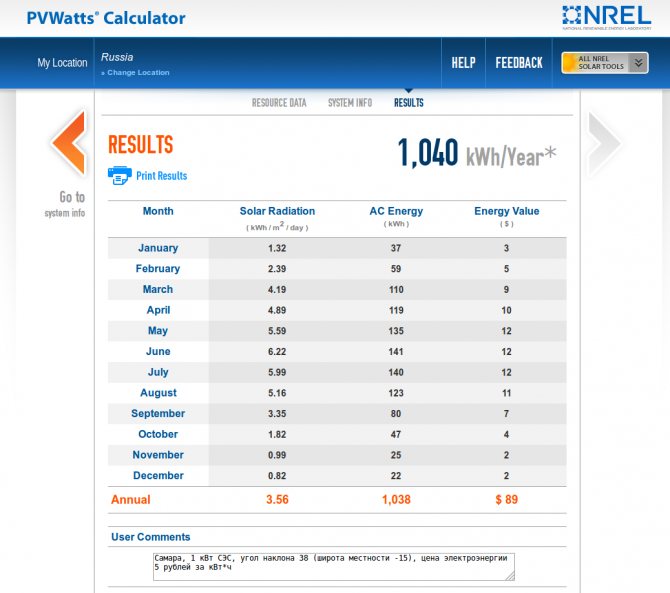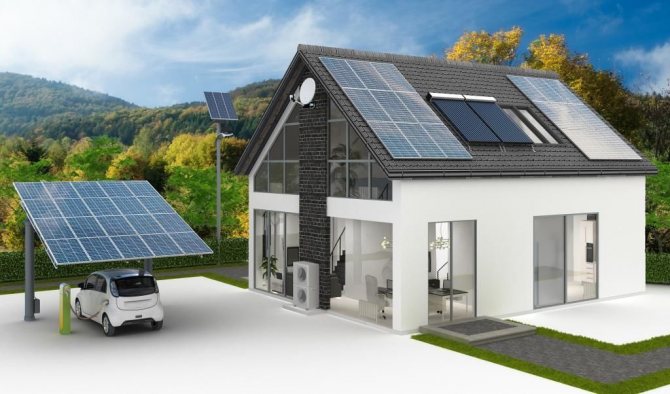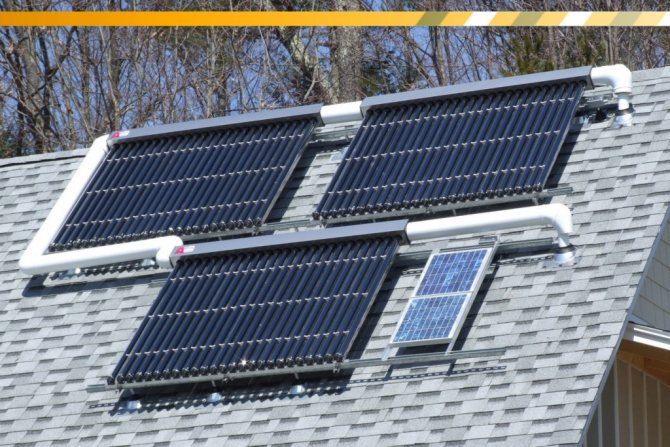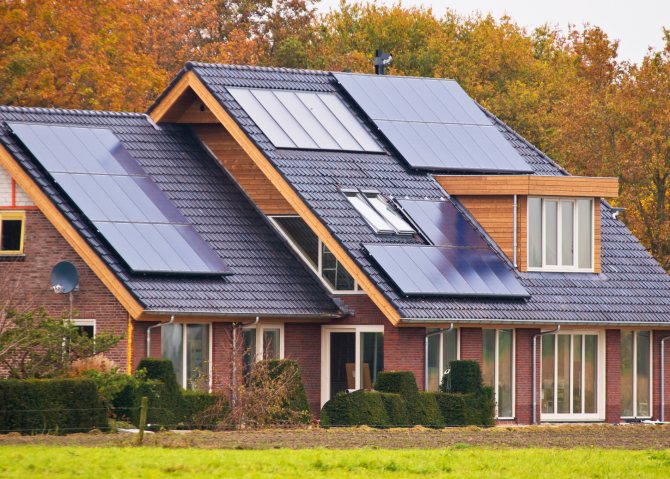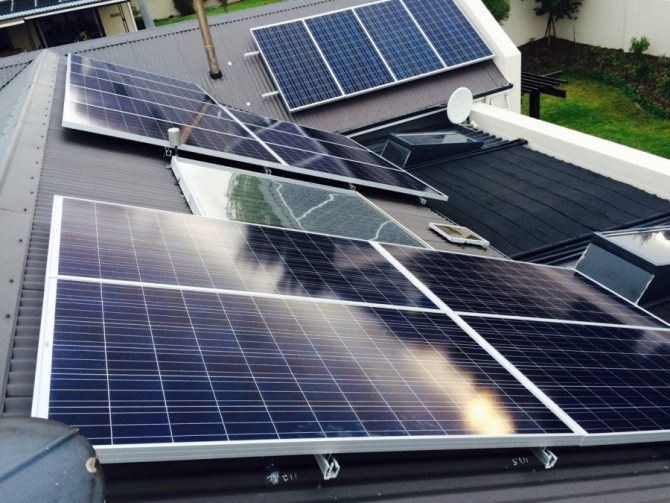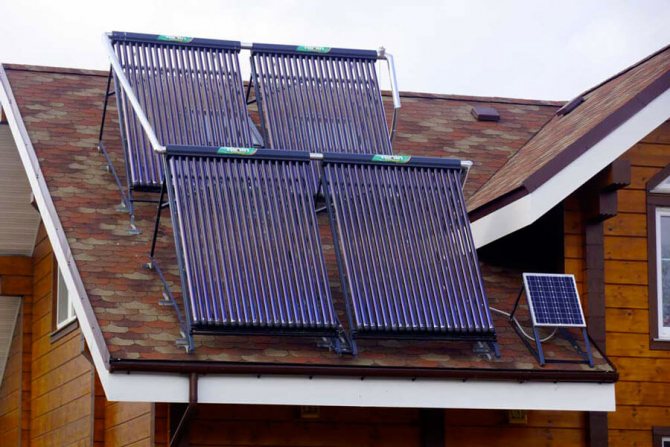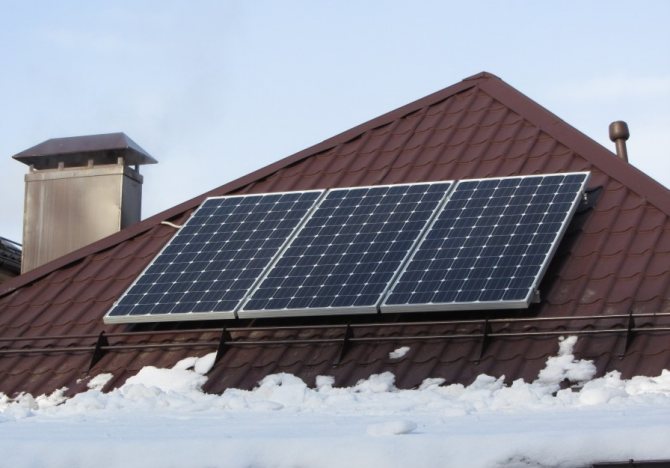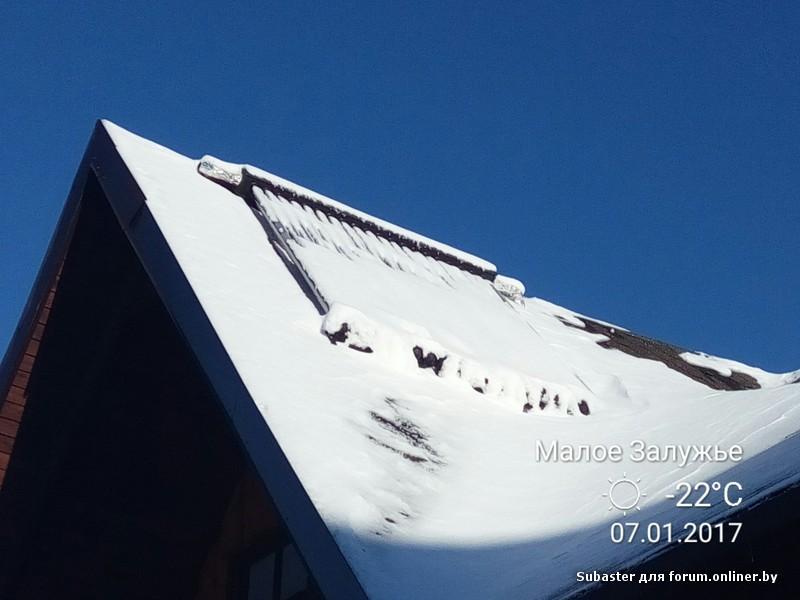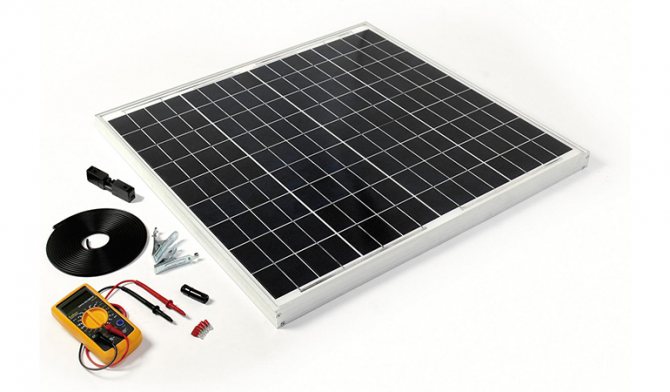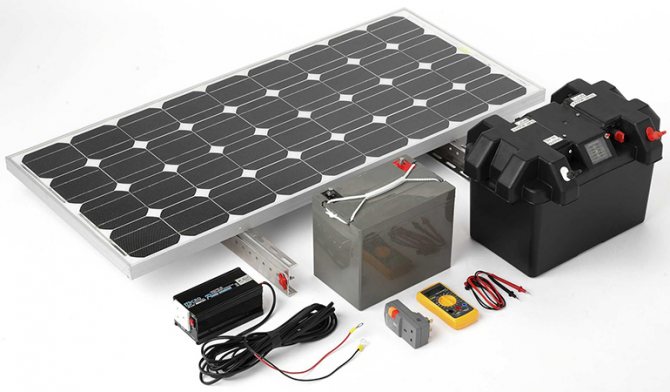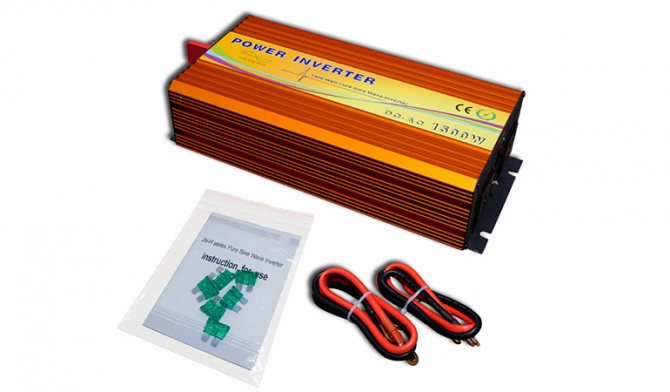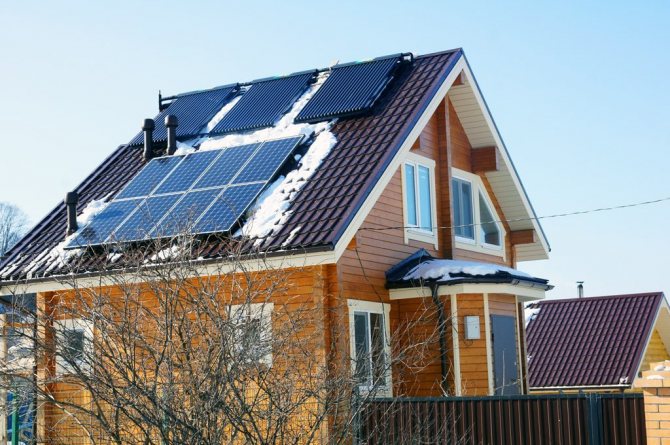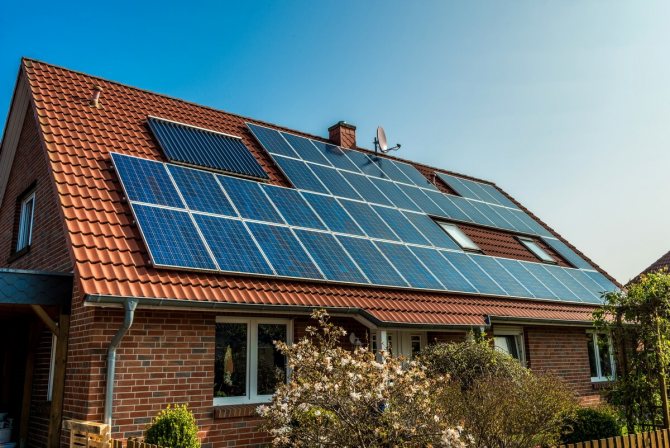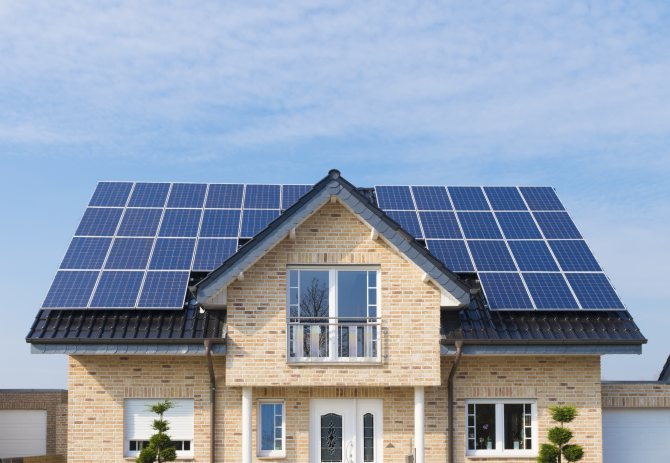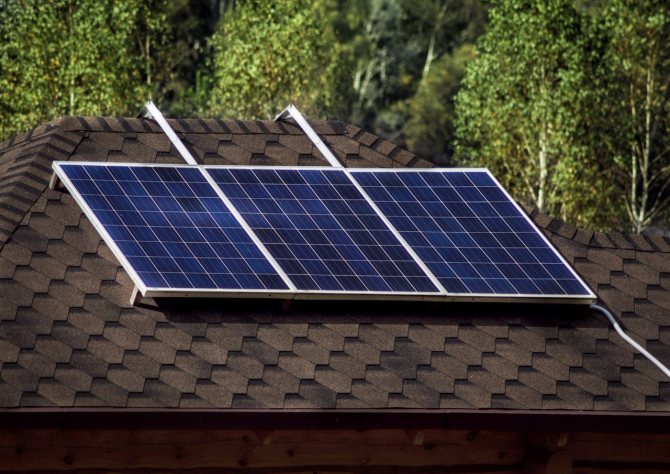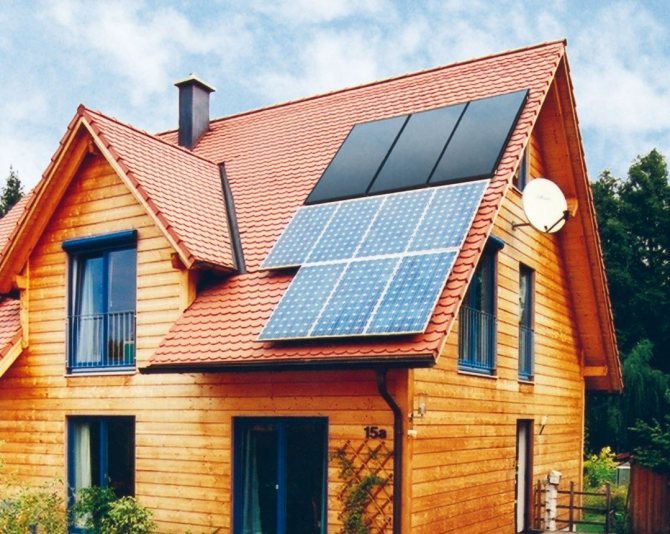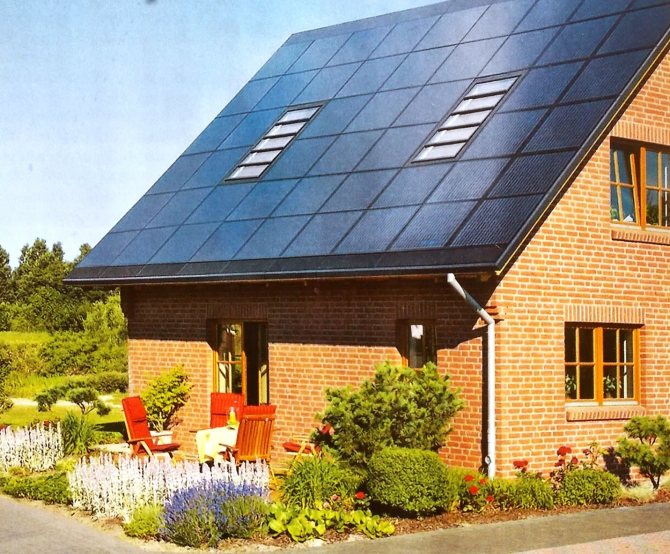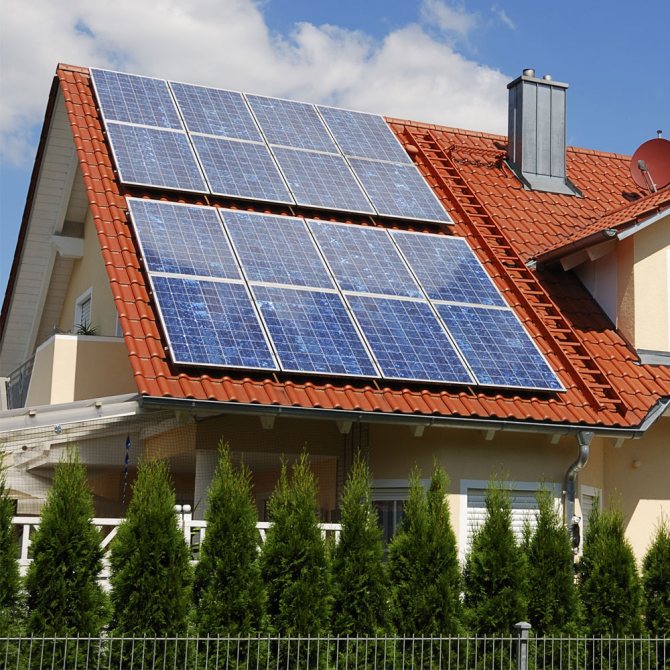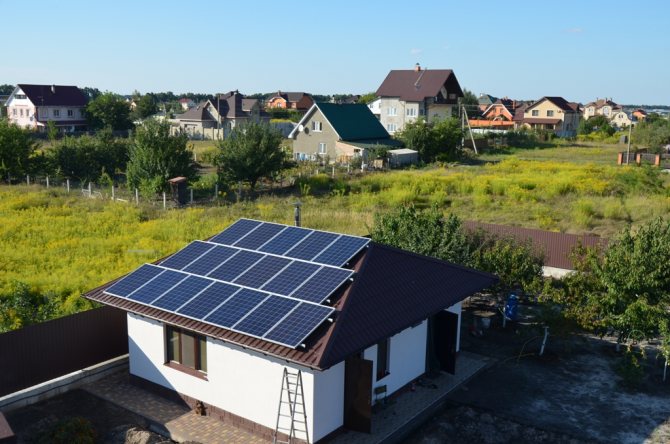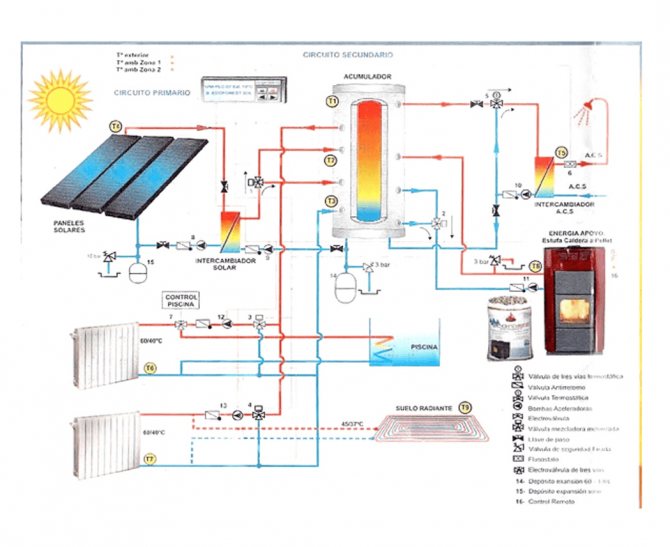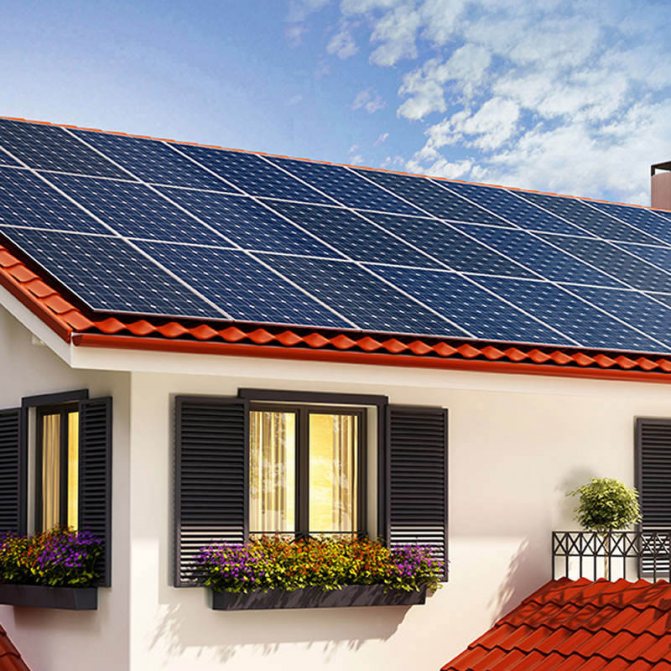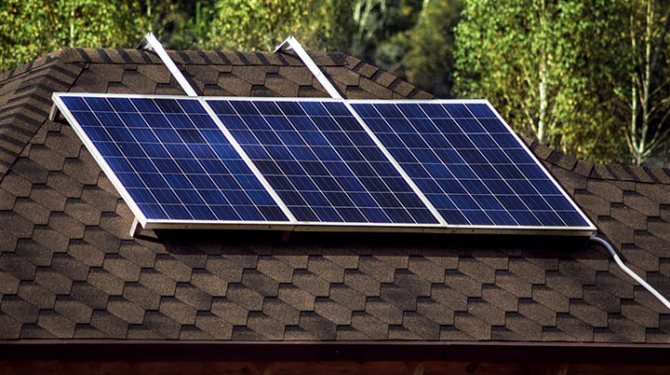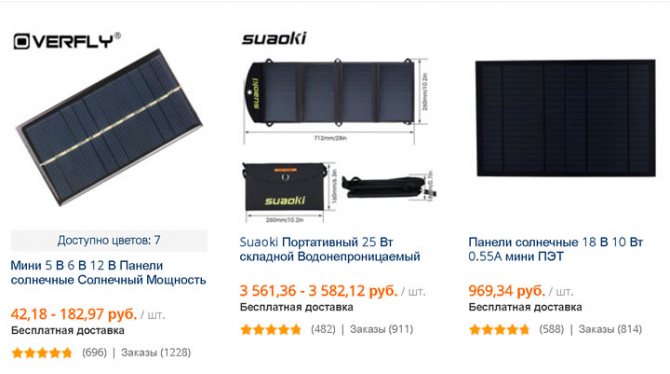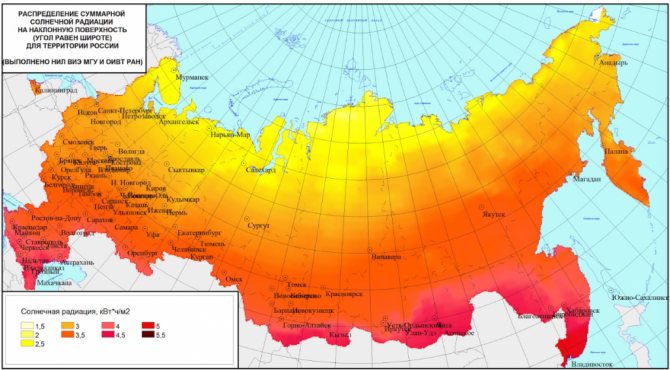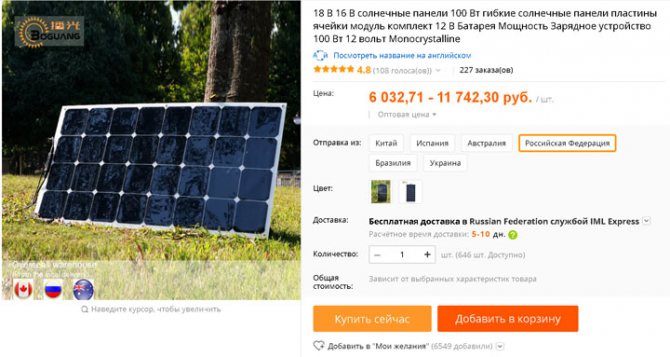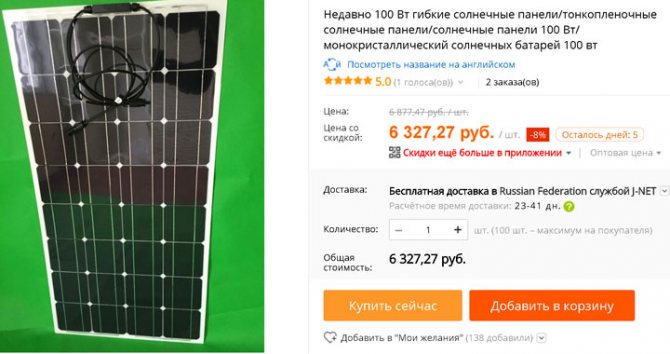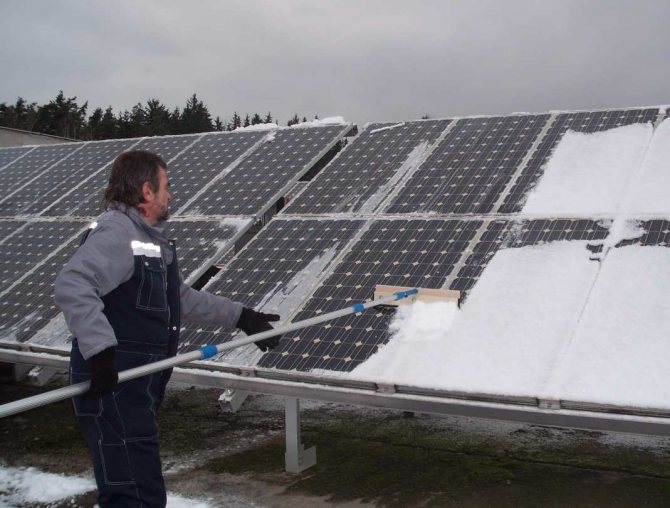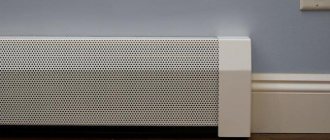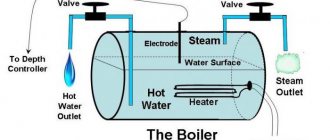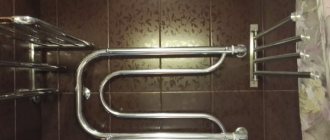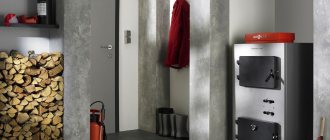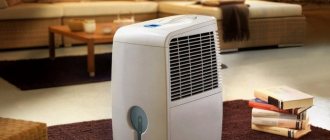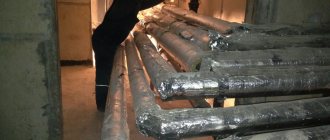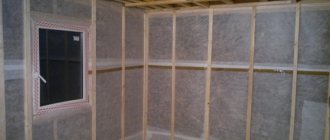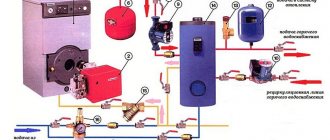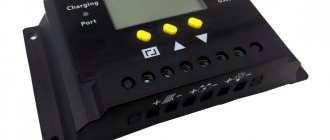Despite the fact that it has become fashionable among Europeans and Americans to heat their homes with solar energy, this technology has not become popular in Russia. Perhaps this is due to our climate, perhaps with the high cost of equipment and its installation.
Nevertheless, we think that many people will be interested in how it works, especially since there are still many remote corners and places in our country where not only there is no gas, but even electricity. It is clear that here it is already worth considering any options for improving your home.
In this article, we will look at how such heating systems are arranged, their pros and cons and installation features.
Benefits and features of real use
No one will give a better assessment than those who have tried the technology for themselves. Are solar panel users satisfied with the solution? We find out what netizens are saying about this.
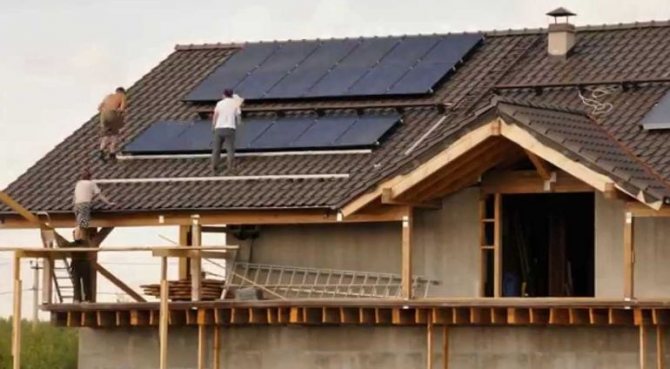
Grid inverters used to operate batteries do not require batteries, which are the weak link in alternative power supplies. Electricity is generated in real time and immediately enters the grid. Theoretical calculations fully correspond to reality, which has been verified in practice. This allows you to plan the cost of purchasing batteries.
However, it is important to make allowances for cloudiness.
What sellers of solar panels are silent about
If you walk through the forums and reviews, you can find such warnings from the happy owners of solar panels.
- The panels require a grid-inverter for operation: when purchasing panels, you need to match the voltage of the inverter and panels for compatibility.
For example, to operate two panels, each of 100 watts, an inverter of 300-500 watts is required.
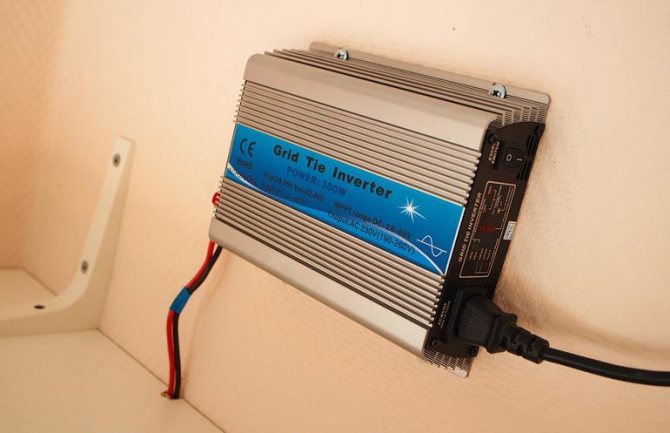

Chinese and usually quite high-quality inverters still often indicate a power that does not correspond to reality on the case. Be careful during the purchase and check the details. The device operates in the presence of mains voltage, therefore it cannot be a backup power source. If electricity is not consumed immediately, it is fed back to the grid. At the same time, the counter turns forward and backward. This is unusual and overlooked by many counters. There is a risk of paying back energy
It is important to take into account the type of meter and include the cost of replacing it in the calculations. If your area is often cloudy, it is important to take it into account and equate it with shade. It is important to consider the time and effort required to clean the panels, especially in winter to remove snow.
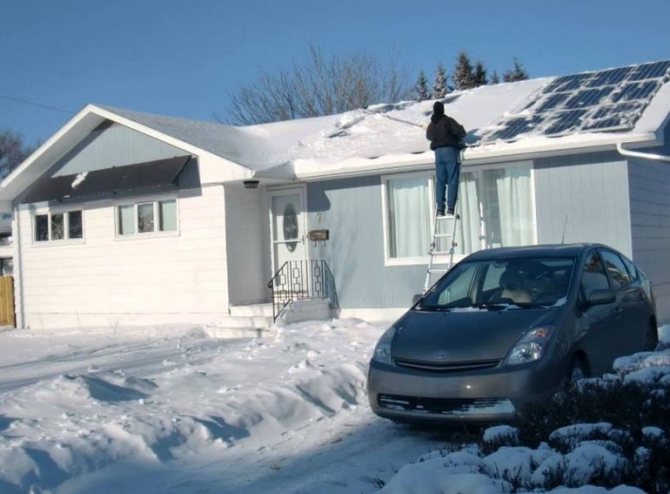

The main conclusion of those who purchased panels in our country is that so far it is too expensive a pleasure, which should be considered as a hobby.
What is important to consider when investing in solar panels
Service
It is not enough to simply install the panels - they need to be looked after. Clean at least, and not only from snow, but also from dust.
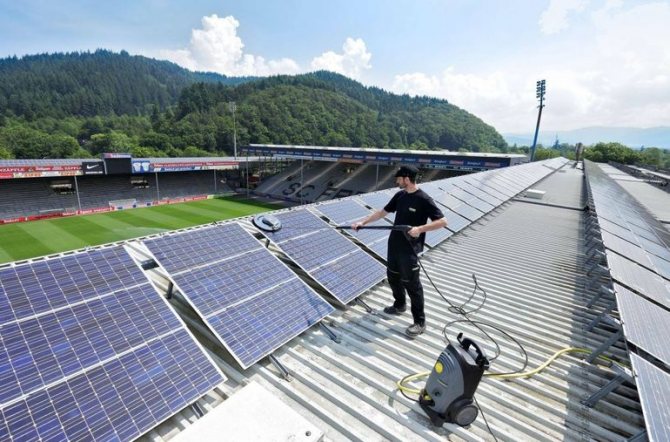

The choice of funds will depend on the area of the batteries and on the economic feasibility of choosing certain forms and means of care. The main thing to understand is that the dust on the panel can reduce its efficiency by 7%.
Snow, dust, bird droppings - all this will lead to a decrease in efficiency.
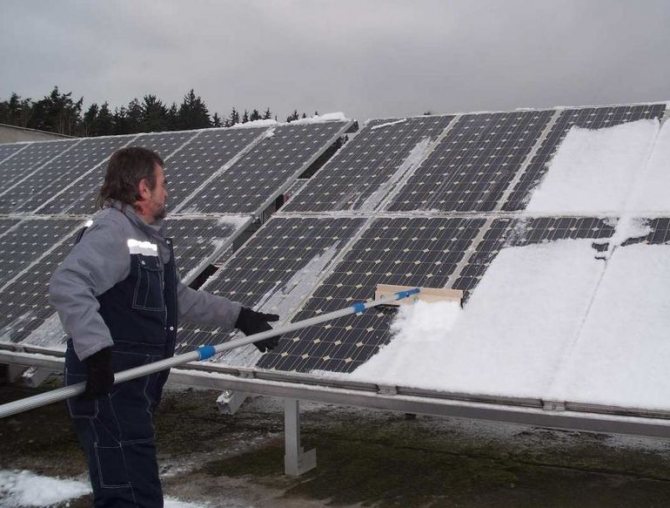

The structure has to be serviced at regular intervals. At least once a quarter, it is worth pouring the panels with a powerful hose filled with water. Considering this, the location of the house should also be taken into account when deciding on the purchase of solar panels. For example, if there is a building nearby - there will be more dust, the panels will have to be cleaned more often. Or less electricity will be produced.
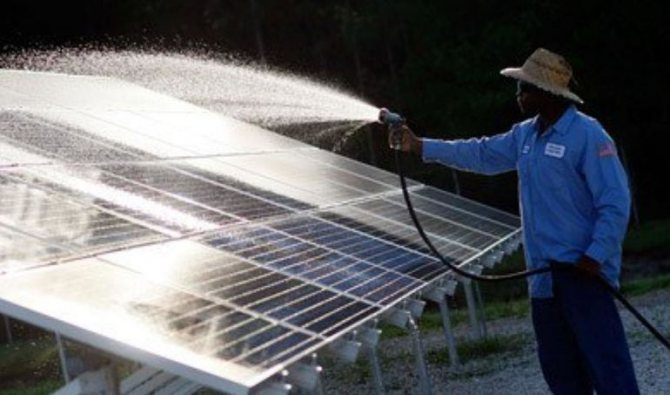

In addition, it is necessary to monitor the serviceability of structures and, in case of mechanical violations, make repairs. You still need to change the batteries, this happens every ten years.
House location
The location of the house affects the effectiveness of the solution. We have already mentioned contamination - the frequency of cleaning the batteries depends on it. The shade will also be a problem for generating the maximum amount of electricity. It can be like the shadow of tall trees on your homestead (you can control it yourself) or the shadow of large buildings nearby (you do not depend on you).
The shadow is important to consider when choosing the type of panels - there are several of them and they react differently to the shadow. Polycrystalline simply reduces the output of electricity, and monocrystalline completely stops the production of electricity on the shaded fragments.
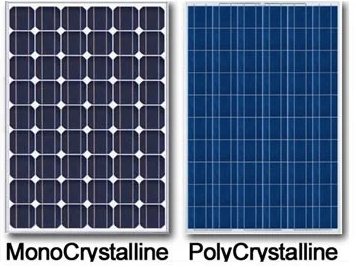

Now the use of batteries is already taken into account before construction, because their efficiency directly depends on how accessible the surface with batteries is to the sun's rays during their maximum activity (usually from 10:00 to 14:00) and all hours of sunshine.
Insolation
In different regions, the earth receives different amounts of sunlight. There is such a thing as insolation - a measure of solar radiation falling on the earth, which is measured in kW / m2 / day. The higher this value, the more electricity can be obtained with fewer solar panels. For example, in the southwest, you will have to spend less to get a certain amount of energy than in the northwest.
Coverage area
To get more electricity from the sun, you need more coverage.
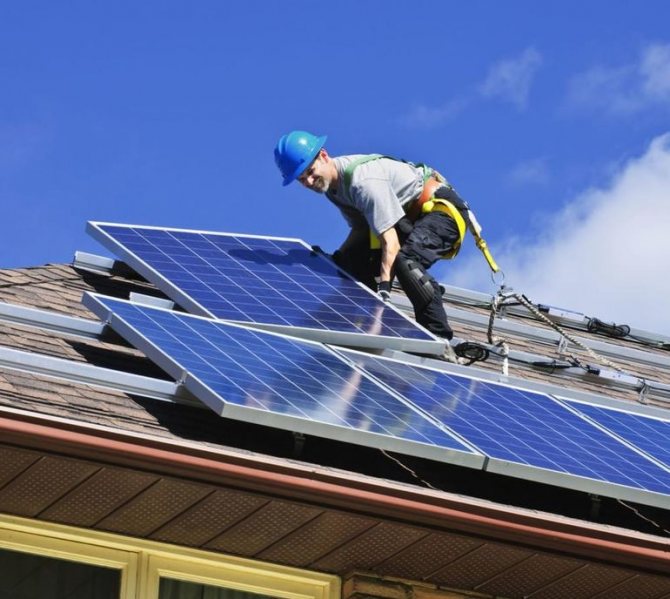

To determine how many batteries you need, you need to find out:
- What is the sun exposure in your area.
- How much electricity do you need.
Find out how much kWh you are using per day and do the calculations.
For example, 30 kWh. We multiply this number by 0.25 and we get 7.5 - which means that you need to get 7.5 kW per day. One standard panel generates 0.12 kW per day. Its parameters are 142x64 cm. You will need 62 panels, which will cover about 65 sq. m. After such calculations, you need to make a correction for insolation and take into account the amount of direct light per day, taking into account the shade. There are a number of other nuances that specialists can take into account.
How much does it cost
Having calculated the quantity, it remains to take into account the cost of acquisition and installation. The good news is that prices for solar panels continue to fall, whereas half a century ago this technology was completely out of the reach of middle-class people.
Now, to serve a large house and receive about 900 kWh per month (30 kWh per day), it will take about 20-40 thousand dollars. You can divide them by the number of years of use and estimate the benefits. Most often, solar energy is used in parallel with standard solutions, supplementing the solar system with electricity from the grid.
Batteries are also rented, which can be a good alternative.
Recycling
Although batteries last up to 50 years, some of their components fail faster (controller lasts 15 years, battery 4-10). The question of disposal arises, when buying it is worth making sure. The fact that the company that produces batteries accepts their components for recycling is done only by 30% of manufacturers.
Experience of using solar vacuum collectors from other countries
Sub ** r, Belarus
From October until the New Year, the water in the reservoir did not heat up more than 16 degrees, the collector was blown out with snow, they say that it was installed incorrectly. On January 7, it was -32 outside, but the sensors and the controller showed that by 12 noon the water warmed up to +30. Probably, I installed a few pipes, it is better to install 30-40 on a tank of 200 liters.
I collected everything myself, maybe there are miscalculations, but I think that equipment sellers are cunning with efficiency. While this is more of an experiment for me, the price and payback period are not entirely encouraging.
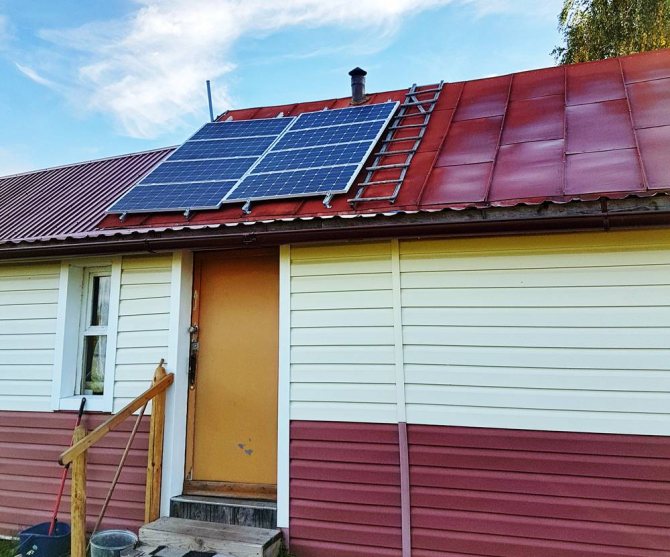

9eb8830d456fc3e23a515ef9402c382a.jpe
I *** rs
We decided to start selling solar collectors and test the vacuum one. We put it to a colleague in a private house. Chosen on the basis of the need - for hot water, with a separate tank, which is installed inside the house. 135 liter tank, one manifold for 12 pipes 58 mm in diameter and 1800 mm in length.
The "owner" is pleased, since the tank, manifold, controller and control unit were given to him for free. The employee bought the rest of the consumables himself.
From July to mid-October, the collector heated one tank per day up to 50 degrees, if it was constantly sunny - 2 tanks. That is, 135 and 270 liters, respectively. In winter, heating is very efficient, judging by the number of pump activations for pumping. We made a mistake with the installation - a large length of pipes (about 30 meters), which means large losses. And the installation of the sensor is incorrect - they were installed in the manifold, and not in the tank. In general, ideally, you need to set two in order to correlate the data through the controller.
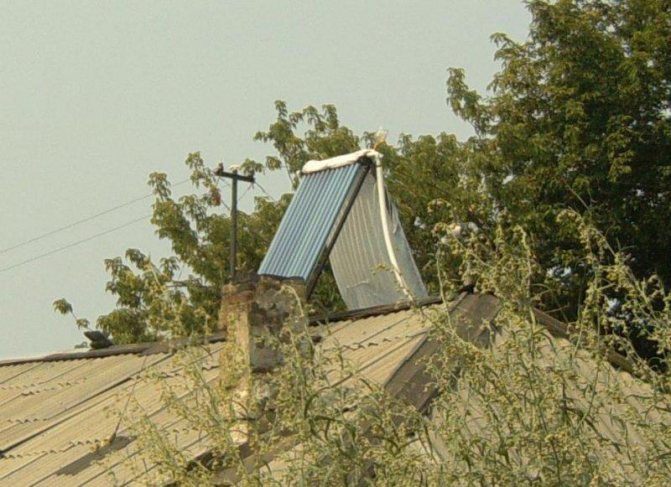

Dmitry, Belarus (sent from comments)
We installed two vacuum collectors of 24 tubes not far from the house. Not enough for heating, but enough for hot water. Water is just boiling water. The installers helped to connect it to the heating system for heating water, and then to the required 70 degrees with a gas boiler.
Savings are evident, gas consumption fell by 30-40%. The winter will pass, we will calculate the payback. The only problem was that it was set at a 45 degree angle. Raised to a position closer to the vertical - productivity has increased. But the heating temperature depends on the cloudiness. Fogs in the morning also affect - on such days, the tank warms up more slowly. And so, quite happy.
Flat solar collectors
These solar heating plants have a simple design and therefore they can be made by hand, if desired. A solid bottom is fixed to the metal frame. A layer of thermal insulation is laid on top. Insulated to reduce losses and housing walls. Then comes the layer of adsorber - a material that absorbs solar radiation well, converting it into heat. This layer is usually black. Pipes are fixed on the adsorber through which the coolant flows. From above, this whole structure is closed with a transparent lid. The material for the cover can be tempered glass or one of the plastics (most often polycarbonate). In some models, the light-transmitting material of the cover can undergo a special treatment: to reduce the reflectivity, it is made not smooth, but slightly matte.
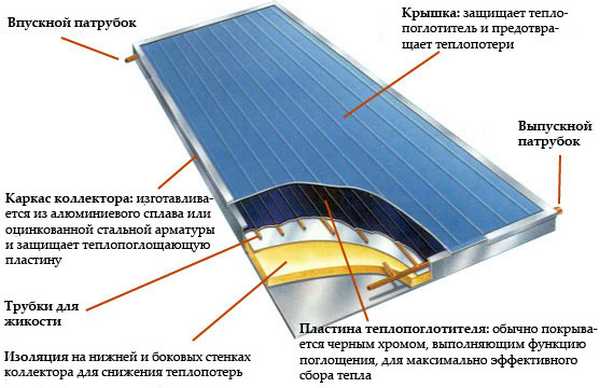

Flat solar collector design
The pipes in a flat solar collector are usually arranged in a snake, there are two holes - an inlet and an outlet. One-pipe and two-pipe connection can be realized. This is as you like. But a pump is needed for normal heat exchange. A gravity system is also possible, but it will be very ineffective due to the low speed of movement of the coolant. It is this type of solar collector that is used for heating, although it can be used to effectively heat water for hot water supply.
There is a variant of a gravity collector, but it is used mainly for heating water. This design is also called a plastic solar collector. These are two transparent plastic plates sealed to the body. Inside there is a labyrinth for the movement of water. Sometimes the bottom panel is painted black. There are two holes - inlet and outlet. Water is supplied inside, as it moves through the labyrinth, it is warmed by the sun, and comes out already warm. This scheme works well with a water tank and easily heats the hot water supply. It is a modern replacement for the conventional barrel mounted on a summer shower. Moreover, a more effective replacement.
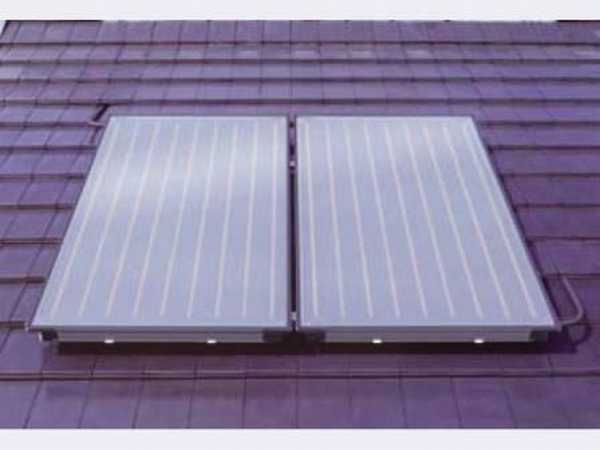

Plastic manifold is used to heat water
How efficient are solar collectors? Among all household solar installations today they show the best results: their efficiency is 72-75%. But not everything is so good:
- they do not work at night and do not work well in cloudy weather;
- large heat losses, especially with wind;
- low maintainability: if something breaks down, then you need to change a significant part, or the entire panel completely.
Nevertheless, heating of a private house from the sun is often done with the help of these solar installations. Such installations are popular in southern countries with active radiation and positive temperatures in winter. They are not suitable for our winters, but they show good results in the summer season.
Advantages and disadvantages of this technology
Any real-life system has its pros and cons, and a solar power plant also has them. The advantages include the following factors:
- Autonomy. Your quality of life will cease to depend on the health of state power grids. It's no secret that periodic power outages are pretty nerve-racking. And if you work at home, then you just need an autonomous power supply, otherwise the lack of electricity can lead not only to moral, but also to material costs.
- Variability. The possibility of a phased increase in power. It is not necessary to convert the entire house to solar energy at once. For starters, one panel and a car battery will be enough, from which you can easily power several LED lights or street lights. As an experiment and to gain the necessary experience, you can start with a solar-powered fountain or an electrifying kitchen. By gradually increasing the power of the system, you can move on to more serious devices, for example, connect fans in the summer and a small heater in the winter. And having thoroughly studied the topic, you can start global projects, transfer heating to solar energy or power the greenhouse.
- Environmental Safety. In the process of generating electrical energy, no harmful elements are released into the environment, and when disposing of failed components, no harmful compounds are formed.
- Legality. You do not need any additional permits to purchase and install solar panels on your roof or an area adjacent to the house.
- Durability. If the elements in the panels are of high quality and connected correctly, and the batteries themselves are installed according to all the rules, the system will serve you for more than a decade.
Now about the disadvantages:
Given the current situation with carbon energy carriers, it is not a question to switch to alternative energy sources or not. The main thing here is to decide which of the renewable resources is right for you. If the information from this article was useful to you, share it with your friends and do not forget to subscribe to our blog, there is still a lot of interesting things ahead.
Benefits
A solar battery for heating a house has several rather significant advantages:
- Your home will be provided with the necessary heat throughout the year. The temperature regime can be adjusted as you like.
- You will gain independence from housing and communal services. Your heating bills will no longer scare you with terrible sums.
- Solar energy may well be used to meet other household needs.
- The solar battery for home heating is characterized by a long service life. The device rarely breaks down, so you don't need to worry about such nuances as replacing or repairing any components.
If you are interested in a solar battery for heating a house, then you should be aware of the important nuances that you need to pay attention to before making the final choice. This system is not suitable for everyone. Geography of residence is one of the factors affecting the efficiency of the system. If the region of your residence is characterized by the fact that the sun does not shine too often, then such solutions will not be so effective. Another disadvantage is that a solar panel for home heating is quite expensive.But here it is important to remember that such a decision will pay for itself very quickly.
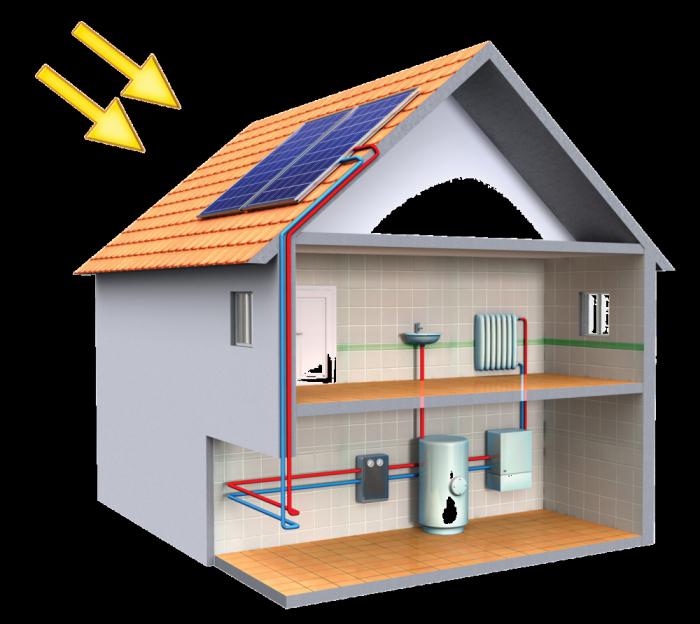

The growing popularity of solar energy
If you search on the Internet, you will find quite a few positive and even rave reviews about solar panels from those who have already installed them. Their popularity is growing for a number of reasons. For example, the cost of using the same gas or coal is constantly growing, and solar power plants are an excellent reserve of energy for homes in small towns, where electricity is often cut off. Solar energy is the best solution for areas where there are no power lines nearby, and there is no technical possibility to install them.
On an industrial scale, the production of such installations is established in countries such as:
- Germany;
- USA;
- China;
- Ukraine;
- Russia.
About technology
It would be wrong to say that this is a new technology. In 1960, astronauts used solar-powered satellites; during the Second World War, many such batteries were installed on homes in the United States, allowing them to receive energy from the sun and heat their homes at its expense.
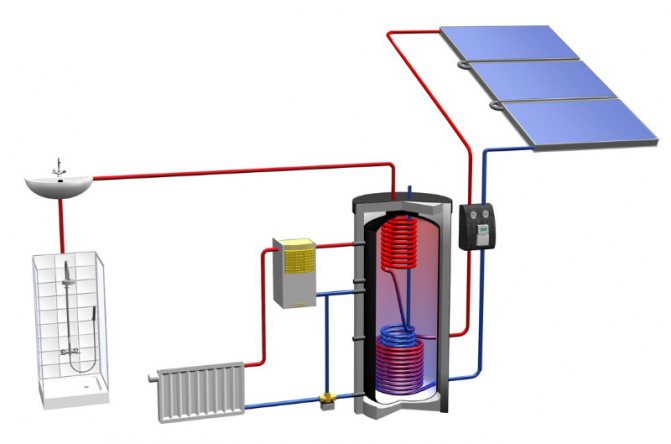

However, it was problematic to introduce the technology everywhere - photovoltaic panels, which are responsible for converting sunlight into electrical energy, are quite expensive technology. It is cost that is often the key factor in making a decision.
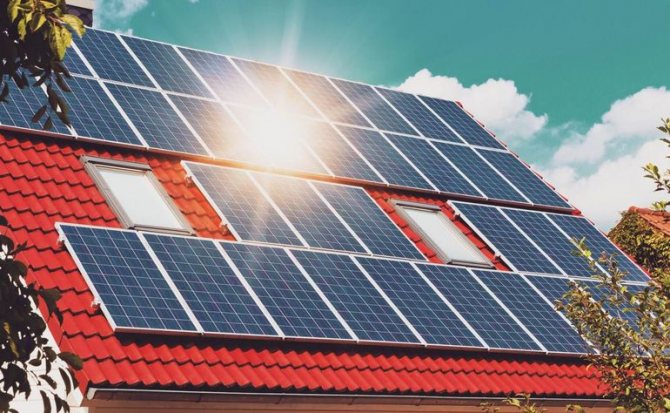

Obviously, for making a decision, it is necessary to take into account a combination of factors. Consider the clear benefits of equipping your home with solar panels:
- The energy of the sun is free and inexhaustible.
- The energy of the sun is environmentally friendly.
- There are no greenhouse gas emissions.
By using solar panels, we practically join the "green movement", take the path of protecting the planet and get free and endless energy.
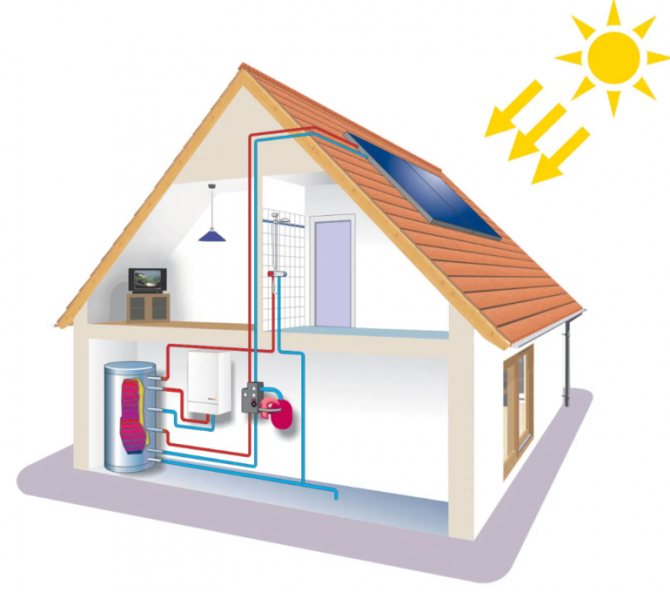

How does a solar battery work? The panel consists of photovoltaic cells connected by a common frame. Each uses a semiconductor material (most often silicon) and an electric field. The semiconductor absorbs the energy of the rays and heats up, releases electrons, directed by the electric field in a certain direction, the flow of electrons forms an electric current. The current through the established contacts is sent to the wires and used for its intended purpose. The current strength depends on the power produced by the photocell.
To increase the efficiency of silicon, impurities are used (atoms of other substances are added to silicon), for example, phosphorus.
In addition, silicon reflects light well, therefore, to reduce losses, the photocells are protected with an anti-reflective coating. And to protect the batteries from mechanical damage, they are covered with glass.
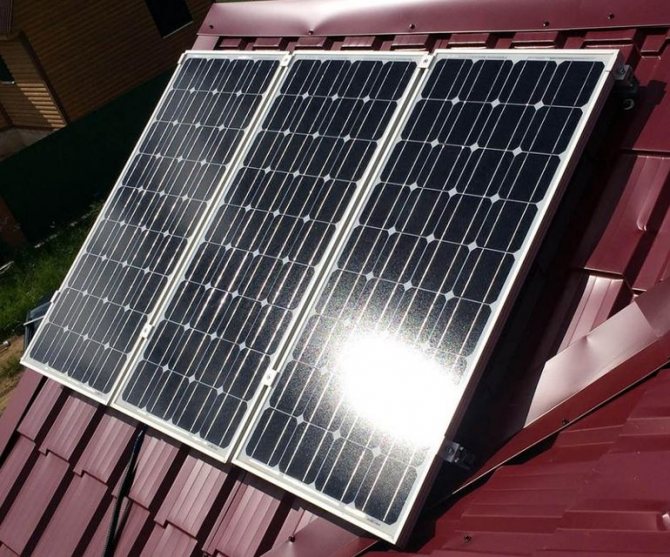

The efficiency of such batteries is rather low - they are able to process only 12-18% of the rays falling on them. The most successful designs achieve an efficiency of 40%.
Heating system device
Let's move on to the system itself.
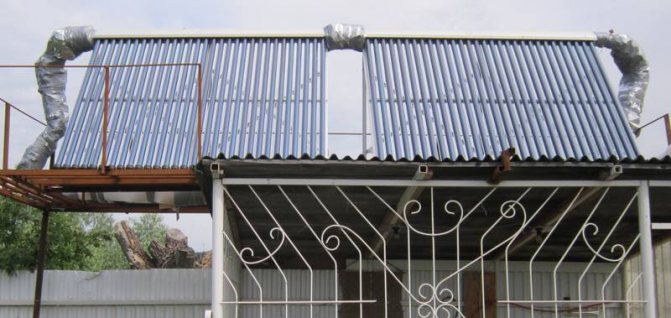

House heating system on solar collectors.
The photo shows the collector itself. It is located on top of the gazebo. Why exactly there, and let's say not on the house? After all, if I placed the collector above the house, then all the costs of the highway through which the coolant functions from the collector to the boiler would be drastically reduced.
My house is located in the longitudinal south-north axis, that is, one roof slope goes to the east, the other to the west. The pediment goes to the south. In theory, the collector could be placed there. In practice, my house is two-story. Therefore, the arrangement of the flyover on the pediment above the second floor is an extremely difficult and costly task. Personally, I have no desire to carry out welding and other work at such a height. And I don't like to hire others. However, suppose that I spent some money and hired a brigade and installed a collector in the area of the pediment. How can I service it later? It is necessary to climb to such a height every time! I would like it to be somehow lower.Moreover, in the summer, morning and evening, the sun does not fall on the pediment (at this time it is either in the west or in the east).
After much thought, I stopped at the gazebo. On its roof and the sun hits the collector from morning until evening, and it is located not so high. For the convenience of location and maintenance of the collector, I welded a whole platform. Concreting two additional pillars. The downside of this location was a significant lengthening of the highway. However, this was already inevitable due to the complexity of the system itself.
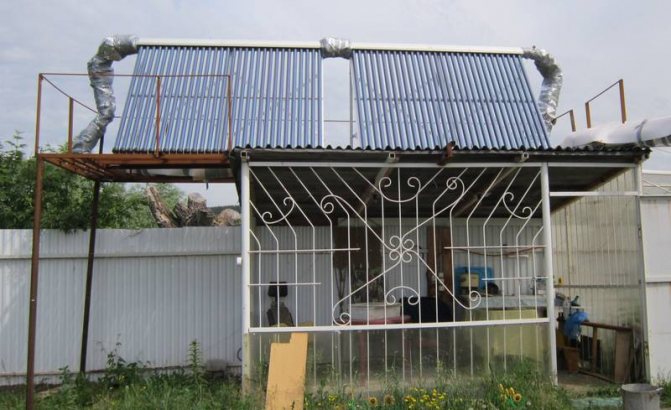

Solar collectors SCH-30 installed on the roof of the gazebo.
So, the photo shows how the highway leaves the collector in the direction of residential buildings. Then the original tube, the stainless corrugation, is bifurcated by 25 mm. In the future, there are two lines from a corrugation of 20 mm. One main line goes to the first floor of the house, where heat removal for heating the heating system is provided by a 150-liter double-circuit boiler integrated into the heating system. In the next photo, he is visible.
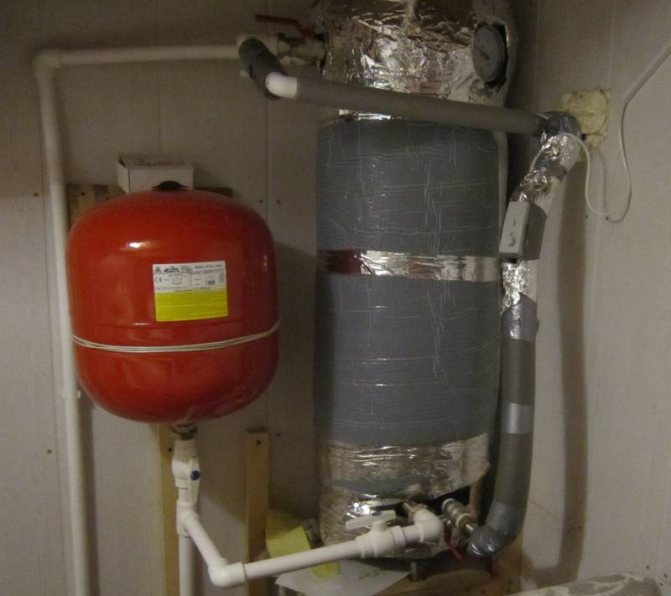

Double-circuit boiler for 150 liters in the house.
The second main goes inside the bath and is connected to the same double-circuit boiler for 150 liters, in which heat is provided for heating the water in the bath. In the same place, one of the controller's sensors is installed on this boiler.
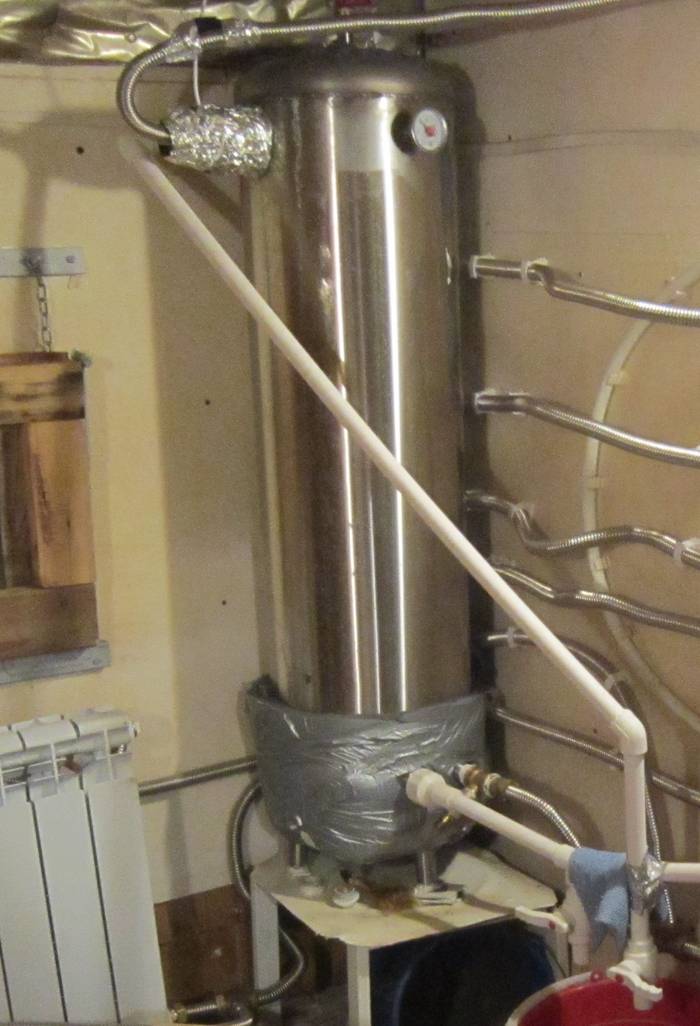

Double-circuit boiler for 150 liters in a bath.
The balance of the flow of coolant between the two lines is carried out manually using a bypass system, conventional ball valves and control valves (from radiators).
Simply put, I can:
- Direct all the heat into the house by turning off the ball valve on the highway to the bathhouse,
- Direct all the heat into the bath by shutting off the ball valve on the highway to the house,
- Open both taps and let the heat evenly into the house and the bath,
- Close the ball valve, and let the coolant through the bypass and control valve, distributing the flows in any proportion that I need. Well, for example, 80% to the bathhouse, and 20% to the house, or vice versa.
Next, let's go to the house.
Double-circuit boiler with a temperature sensor on the inlet line.
The photo shows, if you zoom in, that a temperature sensor is installed on the input line (it is with insulation). When heated to a certain temperature, it turns on the circulation pump, which turns on the circulation in the heating system. Heat is removed from this boiler by the heating system. As a result, water starts heating in a 350-liter buffer tank, which is built into the heating system (it is not visible in the photo). Thus, the total capacity of the water heated from the collector in the house is 150 + 350, a total of 500 liters. This is a heating system. And in the bath there are 150 liters. This is water for consumption. Yes, in the antifrogen system itself, there are about 100 liters. Only 750 liters.
This is a lot. But it should be borne in mind that no matter how the boilers in the house are thermally insulated, there is always heat loss, and even very considerable. The same boilers pass heat not only through thermal insulation, but mainly through metal taps and other fittings screwed into them. In general, if you have plus 30 overboard, and you heated the water at home in boilers, let's say 50 degrees, then the temperature in your room can easily jump to the same 30 degrees, if not higher.
Therefore, initially in the summer in the heat, I intended to produce the main heat in the bath.
So, let's move on to the bath.
When designing a highway in a bath, I initially set myself a specific goal. Namely - heat removal and removal of excess heat from the mains in summer.
Everyone who has dealt with SC issues knows that in our area the production of SC heat in the summer is about 10 times !!! more than in winter. Hence the question - what to do with the excess heat in the summer.
The offers are different:
- Some suggest - to warm up the pools. But I don't have a pool and I don't need one. In addition, this is a significant lengthening of the line.
- Others suggest heating water for irrigation. Personally, my cistern for 11 cubic meters heats up well from the sun. And lead the highway to it, well, very far.
- The most cardinal proposal is to cover the SC with an awning, personally I also do not really like it.
In the Urals, the weather jumps very strongly. Today, plus 30 and you need to get rid of the surplus, and tomorrow it is already below 10 grams and you need to heat the house. Well, every time to run upstairs to unlace the awning, and then put it back on. Not. This is not for me. In addition, in my system, heat can always be needed to heat the bath.
So I thought and the following thought came to my mind.
Where the excess heat will never be superfluous? Even in the hottest summer? In the bath!!! Exactly there! The bathhouse, for its purpose, INITIALLY assumes an increased temperature compared to the street. In the house, plus 30 or 40 - this is not the stuff that is not necessary to anyone, but in the bath this is the very thing.
In general, I decided to use extra heat to warm the air in the bath.
However, there are problems here. The fact is that the power of thermal radiation of devices, for example, heating radiators, is calculated based on a temperature difference of about 70 grams, that is, the temperature of the radiator is taken at 90 grams, and the air temperature in the room is 20 grams. If the temperature in the room is, for example, 40 degrees, and the temperature of the radiator is 60 degrees, then the difference in temperature will be only 20 degrees. That is less than the difference of 70 grams by about 3.5 times. This means that the heat transfer of the radiators in this case will be 3.5 times less than the calculated one.
It is not advisable to raise the temperature of the coolant in the SC system above 80 g. Therefore, when the air in the bath is heated to 60 grams, the difference in temperature will be ONLY 20 grams! Therefore, to ensure good heat removal, powerful installations are needed, otherwise the boiler in the bath will already boil (since heat is transferred to water faster than to air), and the air temperature will still be low.
Initially, I ran a 20 mm corrugated line along the walls of the bath. I wound about 40 meters in total. Translated into cast iron radiators, this is about 26 sections. The photo shows.
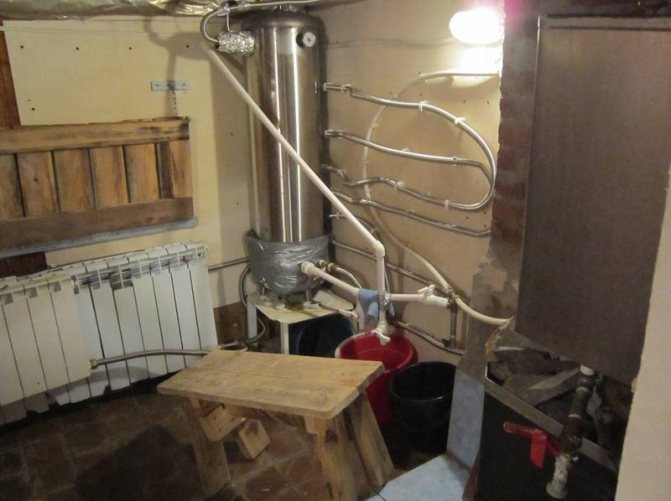

Corrugation as a radiator, installed on the wall of the bath.
When I launched the IC I realized that it was about nothing. Then a stainless steel coil was made to order for me (also in the photo), a pipe with a diameter of 50 mm with a total length of about 10 meters.
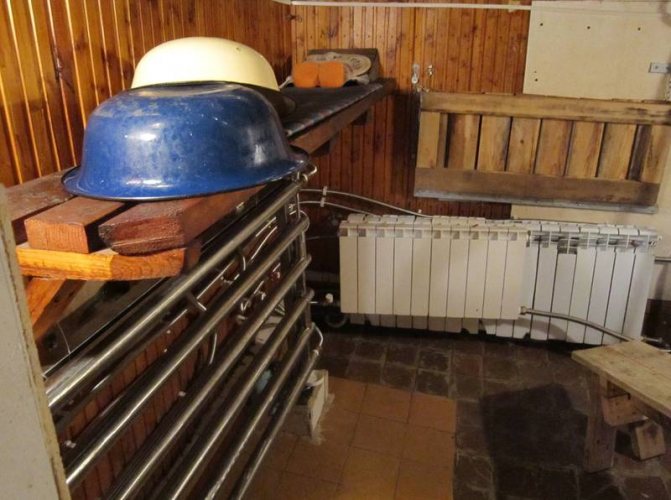

Stainless steel coil.
I felt a little effect. And only when I hung 30 sections of bimetallic radiators with a plus, and also removed almost all the insulation from the boiler, I achieved the desired result.
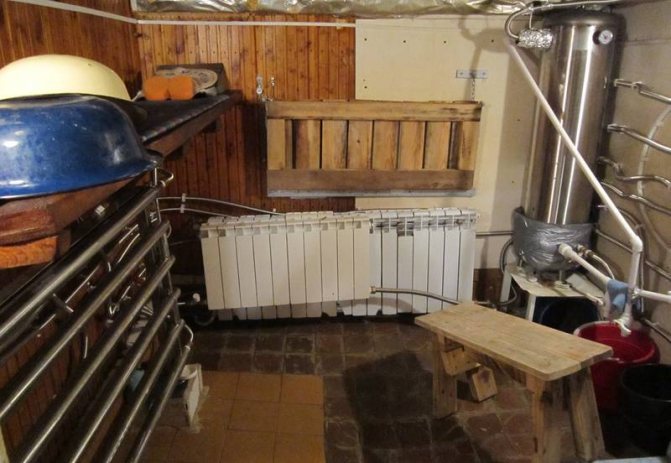

All radiators and a boiler are inside the bath.
In conclusion, I would like to say about the controller in my system. I didn't buy a Chinese controller. Although it was specially created for the SC system, it is CHINESE (I know, Solnechnye.RU have their own opinion on this, but I have my own). Moreover, he had a price tag for 20 thousand.
For myself, I decided that the controller would only buy European.
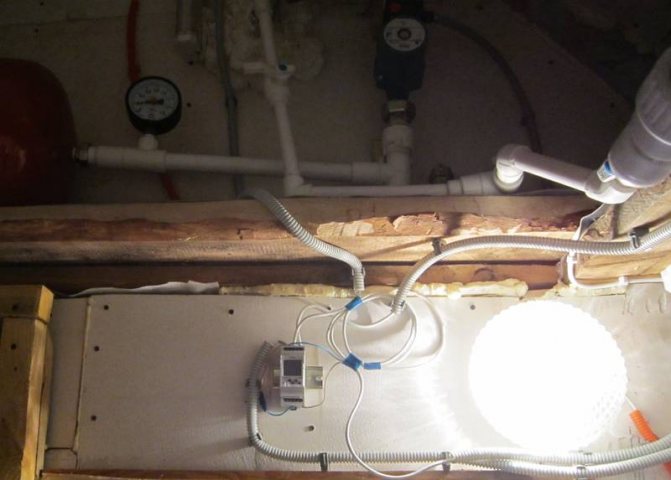

Solar collector controller with piping.
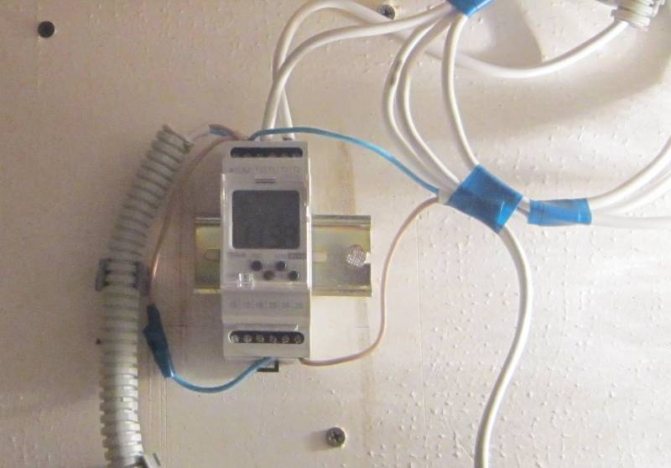

Solar collector controller ТЭР 9.
I bought a European (Czech) TER 9 - thermostat with a differential thermostat function. In terms of functions and settings, it practically does not differ from the Chinese one. But it is EUROPEAN and costs 7 thousand. It just doesn't have one or two additional features. For example, in Chinese there is such a function - when the system overheats, it directs the coolant to the backup heat absorption system (the same pool).
From the description of my system, it is clear that I do not need such a function. By the way, the notorious engineer with experience from the first site made fun of me when he heard that I did not want to use a special controller, but simply choose any suitable one in terms of functions. Oh, how meaningfully he chuckled about this. In fact, choosing a controller turned out to be not so difficult.
Solar panels for home: how they work
In Russia and other countries with cold winters, many doubt the efficiency of such installations, since there is no sun for many days a year, therefore, the accumulated solar energy during the warm season will quickly be wasted during severe frosts.
However, such installations have a sufficiently high power, which ranges from 200 W for one module, they are capable of producing energy throughout the day and are able to catch light even with precipitation or thick clouds. The only negative is a decrease in power in bad weather by about half. But, on the other hand, solar panels have the ability to store energy, which will be given off in case of insufficient sunlight.
The new generation of installations based on amorphous silicon differs from the previous one in that such batteries do not need to be directed into the sun; for their normal operation, an average area will suffice. But they have a significant drawback - a large area must be allocated for their placement. And productivity in northern Russia will be significantly lower than in Crimea or Krasnodar Krai. But at the same time, in the same St. Petersburg, they can still be used with success for a whole year.
99bb6505f517bf2bc42ed72c803598c1.jpe 4e759665bff08246cc552a491745eeb9.jpe
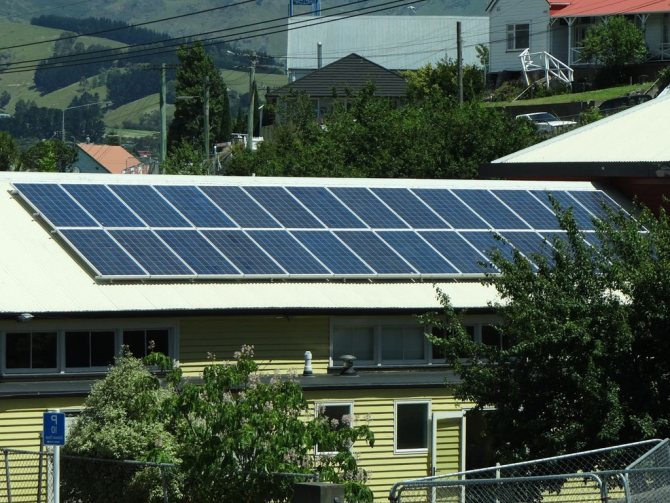

6793705111331a3c99e99d626ef7d14a.jpe
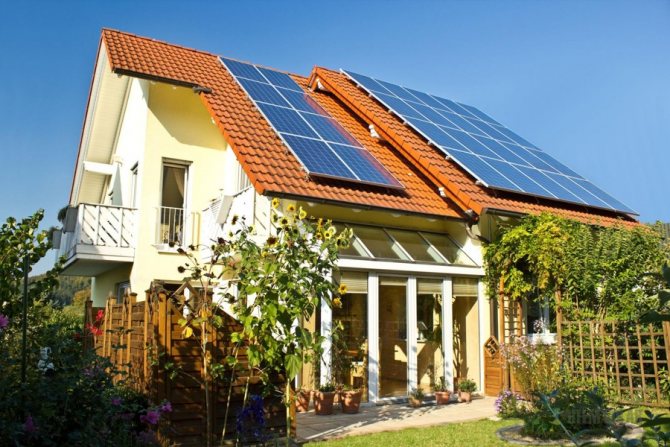

4e5d67ed86018253260bc43e136410ef.jpe
The principle of operation of installations is as follows:
- The generators of electricity in solar panels are models that capture solar energy. They work on the basis of photoelectric reactions and generate current according to the principle of emission of heated bodies;
- the panels are made on the basis of silicon. The efficiency of a single panel is approximately 30 percent at 300 watts. And in order to get the best result, several dozen elements are combined in chains, thanks to which the installations are able to operate in medium cloudiness;
- In order for the temperature in a house with an area of 30 square meters to be comfortable throughout the year, the total area of the modules must be at least 100 square meters, and batteries and distribution equipment must be installed in the house itself. Judging by the reviews of the owners of private houses, this is one of the most difficult conditions for installing solar panels.
Types and configurations of solar panels
All solar panels can be conditionally divided into two types: small and large photovoltaic systems. The first category includes battery panels that operate on a voltage of 12-24 V. These systems are capable of providing electrical energy to a working TV in combination with several heating devices. The use of large systems is intended not only to provide the home with electrical energy, but also to organize the heating system. However, they cannot be used to provide large houses with several floors.
The equipment of the devices also differs. The basic set includes the following list of components:
- vacuum solar collector;
- a controller that monitors the operation of the system at the most efficient level;
- pump supplying the coolant from the collector to the tank of the heating system;
- a container for hot water, the volume of which is 500-1000 liters;
- heat pump or electric heating element.
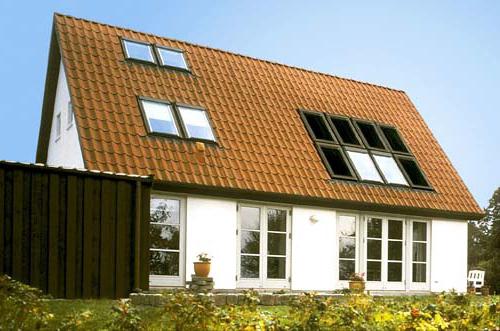

How it works?
Solar cells are composed of silicon wafers. When photons of light hit the crystal lattice of this material, some of the electrons start to move. And from the school physics course, we know that the movement of electrons in a conductor is electricity.
The total energy emitted by the sun in all directions is approximately 385 billion MWh. For every square meter of the surface of this relatively small star, more than 63 kW is accounted for. But, having overcome 150 million kilometers to the ground, the photon beam is fairly scattered and at the equator in clear weather, at noon, the light power is about 1 kV per 1 square meter.

